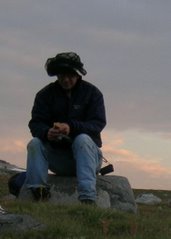
Story on PBS about Peary and the Eskimos and his effort to reach the North Pole...reminds me of Ishi's story...brb...
quote
Ishi (c. 1860 – March 25, 1916) was the name given to the last member of the Yahi, in turn the last surviving group of the Yana people of California. Ishi is believed to be the last Native American in Northern California to have lived the bulk of his life completely outside the European American culture. He emerged from the wild near Oroville, California, leaving his ancestral homeland in the foothills near Lassen Peak.
Ishi means man in the Yahi dialect of Yana; his real name was never known because it was taboo in Yahi society to say one's own name. Since he was the last member of his tribe, his real name died with him.
http://en.wikipedia.org/wiki/Ishi
unquote
quote
In the 1980s, Kenn Harper wrote a book telling Minik's story, "Give Me My Father's Body." Convinced that the remains of Qisuk and the three other adult Inuit who died with him should be returned to Greenland, Harper once again tackled the resistance of the Museum of Natural History (which was reluctant to re-examine the case) and the red tape of two governments. In 1993, he succeeded, and stood before a new grave in Qaanaaq in northern Greenland and witnessed the ceremony denied to Minik nearly a century earlier. Along with Qisuk, the bodies of the three other Inuit from Minik's and Qisuk's group were repatriated as well.
http://en.wikipedia.org/wiki/Minik_Wallace
unquote
quote
After being noticed by townspeople, Ishi was taken into custody by a local sheriff for his own protection. He was then moved to the Museum of Anthropology at the University of California, San Francisco where he lived the remainder of his life in evident contentment, until his death from tuberculosis in 1916.
http://en.wikipedia.org/wiki/Ishi
unquote
Museum specimens...brb...
quote
So for the fourth year in a row, Perry waited for the large ice sheets of frozen northern ocean to melt and break apart. Now on his fifth trip to Greenland, and once again with the steamer Hope, Perry went to Greenland with much to do. This time Peary had four hydraulic jacks capable of lifting 30 tons each. It is obvious Peary very much wanted the stone, but once again it would be very wrong to say the Peary went to Greenland for the meteorite, which is how it sounds in meteorite folklore. Peary even called the stone the "Saviksoah Demon", but perhaps this was because of the many times Peary, the meteorite and "he failed" appeared in print.
http://www.meteorite-times.com/Back_Links/2002/September/colectors_corner.htm
unquote
quote
Ishi, whose life story was first described in the popular book Ishi in Two Worlds by Theodora Kroeber (1961, University of California Press), died of tuberculosis on March 25, 1916. Theodora Kroeber, the wife of Alfred Kroeber, notes in her book that Ishi's brain was removed during an autopsy, although she makes no mention of what happened to it.
The issue drew little notice until 1997, when four Maidu Indian tribes in northern California's Butte County formed a committee to campaign for the return of Ishi's remains for reburial in the Yahi homelands. They knew that his ashes were stored in a cemetery just south of San Francisco. Upon learning that his brain had ended up elsewhere, they launched an effort to find it.
http://www.freerepublic.com/focus/f-news/723008/posts
unquote
quote
The Cape York meteorite, which collided with Earth nearly 10,000 years ago, is named for Cape York, the location of its discovery in Greenland, and is one of the largest iron meteorites in the world.
http://en.wikipedia.org/wiki/Cape_York_meteorite
unquote
pic source
http://www.amnh.org/education/resources/rfl/web/meteoriteguide/images/capeyork_lg.jpg
Now on...Baby Boomers retiring...
quote
For almost a century, the Willamette Meteorite -- the largest meteor found in the U.S. and believed to have come from the asteroid belt between Mars and Jupiter and brought to the museum from the Pacific Northwest in 1906 -- has been seen and touched by generations of awed schoolchildren and other fans of the cosmic mysteries.But as the $210 million Rose Center for Earth and Space opens at 81st Street near Central Park West to crowds that are expected to swell to 4.5 million visitors a year, the destiny of the dark, deeply gouged meteorite, seemingly secure on its steel pedestal in the planetarium's Cullman Hall of the Universe, has been cast into doubt.Acting under a federal law written for the preservation and repatriation of Native American cultural and religious artifacts (NAGPRA), an Indian group in Oregon has submitted a claim for the meteorite, saying it is a holy tribal object that brought messages from the spirit world long before the arrival of white men.
http://www.turtletrack.org/Issues00/Co02262000/CO_02262000_Meteorite.htm
unquote
quote
Even in the monotheistic religions of Judaeo-Christian tradition we find traces of an ancient meteorite cult. In the Hebrew language, meteorites were called "betyls", an equivalent to the Greek "baitylia", meaning "the residence of God". In the Bible, we find a story where Jacob, the ancestor of the Israelites, beds his head on such a betyl-stone in the desert. In his sleep, he has an impressive vision of a stairway to heaven leading directly to the throne of God. The story says that Jacob was full of awe when he awoke, and that he built a temple around that stone. However, nothing of this temple has been preserved up to this day.
http://www.meteorite.fr/en/basics/history.htm
unquote
DavidDavid



No comments:
Post a Comment